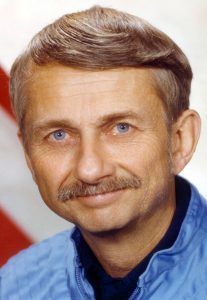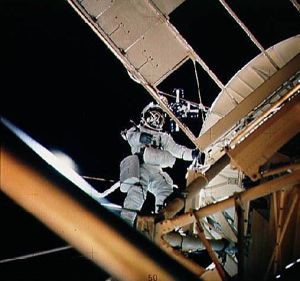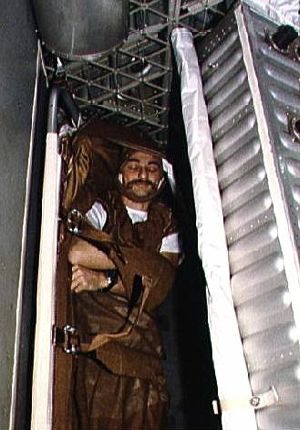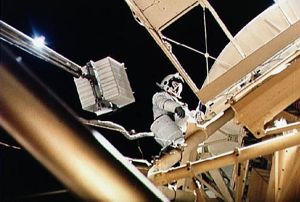
Home - Search - Browse - Alphabetic Index: 0- 1- 2- 3- 4- 5- 6- 7- 8- 9
A- B- C- D- E- F- G- H- I- J- K- L- M- N- O- P- Q- R- S- T- U- V- W- X- Y- Z
Garriott, Owen Kay
 Garriot Credit: www.spacefacts.de |
Status: Inactive; Active 1965-1986. Born: 1930-11-22. Spaceflights: 2 . Total time in space: 69.79 days. Birth Place: Enid, Oklahoma.
Educated Oklahoma; Stanford. 1961 - 1965 taught electronics, electromagnetic theory, and ionospheric physics as professor at Stanford.
Official NASA Biography as of June 2016:Owen K. Garriott (Ph.D.)
NASA Astronaut (former)
PERSONAL DATA: Born November 22, 1930 in Enid, Oklahoma.
EDUCATION: Graduated from Enid High School in 1948; received a B.S. in Electrical Engineering from the University of Oklahoma in 1953 and a M.S. and Ph.D from Stanford University in Electrical Engineering in 1957 and 1960, respectively. Completed one year U.S. Air Force Pilot Training Program (1966), receiving qualification as pilot in jet aircraft.
ORGANIZATIONS: American Astronautical Society (Fellow), American Institute of Aeronautics and Astronautics (Associate Fellow), Institute of Electrical and Electronic Engineers, American Geophysical Union, American Association for the Advancement of Science, Association of Space Explorers (Board of Directors), Astronaut Scholarship Foundation (Vice President and Vice Chairman).
SPECIAL HONORS: National Science Foundation Fellowship, 1960-61; Honorary Doctorate of Science, Phillips University (Enid, OK), 1973; NASA Distinguished Service Medal, 1973; Collier Trophy for 1973; Federation Aeronautique International, Komarov Diploma for 1973; Goddard Memorial Trophy for 1975; NASA Space Flight Medal, 1983; and additional awards related to his space flights, including the Oklahoma Hall of Fame (1980), Oklahoma Air and Space Hall of Fame (1980), the U.S. Astronaut Hall of Fame (1997), the Oklahoma Military Hall of Fame (2000) and Enid Public Schools Hall of Fame (2001).
EXPERIENCE: Served as electronics officer on active duty in the U.S. Navy from 1953 to 1956. From 1961 through 1965 he was an Assistant Professor, then Associate Professor in the Department of Electrical Engineering at Stanford University. He performed research and led graduate studies in ionospheric physics after obtaining his doctorate and authored or co-authored more than 45 scientific papers, chapters and one book, principally in areas of the physical sciences.
In 1965 he was one of the first six Scientist-Astronauts selected by NASA. His first space flight aboard Skylab in 1973 set a new world record for duration of approximately 60 days, more than double the previous record. Extensive experimental studies of our sun, of earth resources and in various life sciences relating to human adaptation to weightlessness were made.
His second space flight was aboard Spacelab-1 in 1983, a multidisciplinary and international mission of 10 days. Over 70 separate experiments in six different disciplines were conducted, primarily to demonstrate the suitability of Spacelab for research in all these areas. He operated the world's first Amateur Radio Station from space, W5LFL, which has since expanded into an important activity on dozens of Shuttle flights, Space Station MIR and now the International Space Station, with scores of astronauts and cosmonauts participating.
Between these missions, he received a NASA fellowship for one year's study at Stanford (1975-76) and held the posts of Deputy, Acting and Director of Science and Applications at Johnson Space Center, (1974-75, 76-78). In the latter post he was responsible for all research in the physical sciences at the Johnson Space Center. From 1984 to 1986, he held the position of Project Scientist in the Space Station Project Office. In this position he worked closely with the external scientific communities and advised the Project Manager concerning the scientific suitability of the Space Station design.
After leaving NASA in June, 1986, he consulted for various aerospace companies and served as a member of several NASA and National Research Council Committees.
From January 1988 until May 1993, he was Vice President of Space Programs at Teledyne Brown Engineering. This Division, which grew to over 1,000 people, provided payload integration for all Spacelab projects at the Marshall Space Flight Center and had a substantial role in the development of the U.S. Laboratory for the International Space Station.
He has devoted additional time to several charitable activities in his home town, including the Enid (OK) Arts and Sciences Foundation of which he was a co-Founder in 1992. More recently, he has accepted a position as Adjunct Professor in the Laboratory for Structural Biology at the University of Alabama in Huntsville (UAH) and has participated in research activities there involving new microbes he has returned from extreme environments such as very alkaline lakes and deep sea hydrothermal vents. Hyperthermophiles were returned from several dives in Russian MIR submersibles to the Rainbow Vents at a depth of 2,300 meters near the Azores in the Atlantic Ocean. Other research activities included three trips to Antarctica from which 20 meteorites were returned for laboratory study.
AUGUST 2002
This is the only version available from NASA. Updates must be sought from the above named individual.
NASA Official Biography
NAME: Owen K. Garriott (Ph.D.)
NASA Astronaut (former)
PERSONAL DATA: Born November 22, 1930, in Enid, Oklahoma. Married to Evelyn (Eve) L. Garriott from Huntsville, Al. He has four children from a previous marriage: Randall, Robert, Richard, and Linda. Recreational interests include skiing, sailing, scuba diving, and amateur radio.
EDUCATION: Graduated from Enid High School; received a bachelor of science degree in electrical engineering from the University of Oklahoma in 1953, a master of science degree and a doctor of philosophy degree in electrical engineering from Stanford University in 1957 and 1960, respectively; and presented an honorary doctor of philosophy degree in science from Phillips University (Enid, Oklahoma) in 1973.
ORGANIZATIONS: Fellow of the American Astronautical Society; Associate Fellow of the American Institute of Aeronautics and Astronautics; and member of the American Geophysical Union, the Institute of Electrical and Electronic Engineers, Tau Beta Pi, Sigma XI, the International Scientific Radio Union (URSI), and the American Association for the Advancement of Science.
SPECIAL HONORS: National Science Foundation Fellowship at Cambridge University and at the Radio Research Station at Slough, England, 1960-1961; the NASA Distinguished Service Medal in 1973; the City of Chicago Gold Medal in 1974, the Robert J. Collier Trophy for 1973 in 1974; the Federation Aeronautique Internationale's V. M. Komarov Diploma for 1973 in 1974; the Dr. Robert H. Goddard Memorial trophy for 1975; Education for Public Management Fellowship at Stanford University, 1975-1976; and elected to the International Academy of Astronautics in 1975. Recipient of NASA Space Flight Medal (1983).
EXPERIENCE: Garriott served as an electronics officer
while on active duty with the United States Navy from 1953 to 1956, and was
stationed aboard several U.S. destroyers at sea.
From 1961 until 1965, he taught electronics, electromagnetic theory, and
ionospheric physics as an associate professor in the Department of Electrical
Engineering at Stanford University. He has performed research in ionospheric
physics since obtaining his doctorate and has authored or co-authored more than
40 scientific papers and one book on this subject.
NASA EXPERIENCE: Dr. Garriott was selected as a
scientist-astronaut by NASA in June 1965. He then completed a 53-week course in
flight training at Williams Air Force Base, Arizona.
He has since logged over 5,000 hours flying time--including over 2,900 hours in
jet aircraft and the remainder in spacecraft, light aircraft and helicopters. In
addition to NASA ratings, he holds FAA commercial pilot and flight instructor
certification for instrument and multi-engine aircraft.
Dr. Garriott was science-pilot for Skylab-3 (SL-3), the second manned Skylab
mission, and was in orbit from July 28 to September 25, 1973. With him on this
59-1/2-day flight were Alan L. Bean (spacecraft commander) and Jack R. Lousma
(pilot). SL-3 accomplished 150% of many mission goals while completing 858
revolutions of the Earth and traveling some 24,400,000 miles. The crew installed
six replacement rate gyros used for attitude control of the spacecraft and a
twin pole sunshade used for thermal control, and repaired nine major experiment
or operational equipment items. They devoted 305 manhours to extensive solar
observations and completed 333 medical experiment performances to obtain
valuable data on the effects of extended weightlessness on man. Skylab-3 ended
with a Pacific Ocean splashdown and recovery by the USS New ORLEANS.
The crew of Skylab-3 logged 1,427 hours and 9 minutes each in space, setting a
new world record for a single mission, and Garriott also spent 13 hours and 43
minutes in three separate extravehicular activities outside the orbital
workshop.
Following his Skylab flight, Dr. Garriott served as Deputy and then Director of
Science and Applications, and as the Assistant Director for Space and Life
Science at the Lyndon B. Johnson Space Center. He later served (1984-1986) as
the Space Station Project Scientist.
Dr. Garriott was a mission specialist on STS-9/Spacelab-1 which launched from
Kennedy Space Center, Florida, on November 28, 1983. He was accompanied by
spacecraft commander, Mr. John W. Young; pilot, Lt. Col. Brewster H. Shaw, Jr.;
fellow mission specialist, Dr. Robert A. Parker; and payload specialists, Dr.
Byron Lichtenberg and Dr. Ulf Merbold. This six-man crew was the largest yet to
fly aboard a single spacecraft, the first international shuttle crew, and the
first to carry payload specialists.
During this maiden flight of the European Space Agency (ESA) - developed
laboratory, the crew conducted more than 70 multi-disciplinary scientific and
technical investigations in the fields of life sciences, atmospheric physics and
Earth observations, astronomy and solar physics, space plasma physics, and
materials processing. In off duty hours, the first manned amateur radio
operations in space were conducted, using Garriott's station call, W5LFL.
After 10-days of Spacelab hardware verification and around-the-clock scientific
operations, Columbia and its laboratory cargo landed on the dry lakebed at
Edwards Air Force Base, California, on December 8, 1983
Dr. Garriott resigned from the NASA in 1986 and later served as Vice President,
Space Programs for Teledyne Brown Engineering in Huntsville, AL (1988-1993). He
is currently a co-founder and President of Immutherapeutics, Inc. in Huntsville.
JANUARY 1996
More at: Garriott.
Family: Astronaut. Country: USA. Spacecraft: Skylab. Flights: Skylab 3, STS-9, STS-61-K. Projects: STS. Agency: USN. Bibliography: 12, 5420.
 | Skylab 3 Astronaut Owen Garriott participates in EVA to deploy twin pole solar shield Credit: NASA |
 | Skylab 3 View of Astronaut Owen Garriott in sleep restraints Credit: NASA |
 | Skylab 3 Astronaut Owen Garriott participates in EVA to deploy twin pole solar shield Credit: NASA |
1930 November 22 - .
- Birth of Dr Owen Kay Garriott - . Nation: USA. Related Persons: Garriott. American scientist mission specialist astronaut 1965-1986. 2 spaceflights, 69.8 days in space. Flew to orbit on Skylab 3 (1973), STS-9..
1965 June 28 - .
- NASA Astronaut Training Group 4 selected. - .
Nation: USA.
Related Persons: Garriott,
Gibson, Edward,
Graveline,
Kerwin,
Michel,
Schmitt.
The group was selected to provide scientist-astronauts for Apollo lunar landing and earth-orbit space station missions.. Qualifications: Doctorate in natural sciences, medicine, or engineering. Under 35 years old, under 183 cm height, excellent health. US citizen.. 1,351 applicants. The National Academy of Science was responsible for the final selection. NASA planned to select up to twenty, but the quality of the applicants was considered so poor that only six were named. Of those, four would fly in space. Geologist Schmitt would walk on the moon on the last Apollo mission, and only after pressure from the scientific community. The other three would fly on Skylab. Only Garriot would fly twice, supplementing his 59 days on Skylab with a ten-day shuttle mission.
1973 July 28 - . 11:10 GMT - . Launch Site: Cape Canaveral. Launch Complex: Cape Canaveral LC39B. Launch Platform: LUT1. LV Family: Saturn I. Launch Vehicle: Saturn IB.
- Skylab 3 - .
Call Sign: Skylab. Crew: Bean,
Garriott,
Lousma.
Backup Crew: Brand,
Lenoir,
Lind.
Payload: Apollo CSM 117. Mass: 20,121 kg (44,359 lb). Nation: USA.
Agency: NASA Houston.
Program: Skylab.
Class: Moon.
Type: Manned lunar spacecraft. Flight: Skylab 3.
Spacecraft: Apollo CSM.
Duration: 59.46 days. Decay Date: 1973-09-25 . USAF Sat Cat: 6757 . COSPAR: 1973-050A. Apogee: 442 km (274 mi). Perigee: 422 km (262 mi). Inclination: 50.00 deg. Period: 93.20 min.
Continued maintenance of the Skylab space station and extensive scientific and medical experiments. Installed twinpole solar shield on EVA; performed major inflight maintenance; doubled record for length of time in space. Completed 858 Earth orbits and 1,081 hours of solar and Earth experiments; three EVAs totalled 13 hours, 43 minutes.
The space vehicle, consisting of a modified Apollo command and service module payload on a Saturn IB launch vehicle, was inserted into a 231.3 by 154.7 km orbit. Rendezvous maneuvers were performed during the first five orbits as planned. During the rendezvous, the CSM reaction control system forward firing engine oxidizer valve leaked. The quad was isolated. Station-keeping with the Saturn Workshop began approximately 8 hours after liftoff, with docking being performed about 30 minutes later.
1973 August 7 - . 17:30 GMT - .
- EVA Skylab 3-1 - .
Crew: Garriott,
Lousma.
EVA Duration: 0.27 days. Nation: USA.
Related Persons: Garriott,
Lousma.
Program: Skylab.
Class: Manned.
Type: Manned space station. Flight: Skylab 3.
Spacecraft: Skylab.
Installed second sunshade. Replaced solar camera film cartridges. During EVA by crew members of Skylab 3, a twin-boom sunshade, developed by MSFC, was deployed over the parasol of the OWS. A redesigned and refined thermal parasol had been launched with Skylab 3. However, its use would have required jettisoning the parasol deployed by crew members of Skylab 2, with the possibility of creating the same thermal problems that existed on the OWS prior to the parasol deployment. Following erection of the twin-pole sunshade, the cabin temperature stayed at a comfortable 293-297 K (67.7°F-74.9°F).
1973 August 24 - . 16:24 GMT - .
- EVA Skylab 3-2 - . Crew: Garriott, Lousma. EVA Duration: 0.19 days. Nation: USA. Related Persons: Garriott, Lousma. Program: Skylab. Class: Manned. Type: Manned space station. Flight: Skylab 3. Spacecraft: Skylab. Replaced solar camera film cartridges; installed replacement gyroscopes..
1973 September 22 - . 11:18 GMT - .
- EVA Skylab 3-3 - . Crew: Bean, Garriott. EVA Duration: 0.11 days. Nation: USA. Related Persons: Bean, Garriott. Program: Skylab. Class: Manned. Type: Manned space station. Flight: Skylab 3. Spacecraft: Skylab. Replaced film cartridges for solar camera..
1973 September 25 - . 22:19 GMT - .
- Landing of Skylab 3 - . Return Crew: Bean, Garriott, Lousma. Nation: USA. Related Persons: Bean, Garriott, Lousma. Program: Skylab. Flight: Skylab 3. Skylab 3 landed at 22:19 GMT..
1983 November 28 - . 16:00 GMT - . Launch Site: Cape Canaveral. Launch Complex: Cape Canaveral LC39A. Launch Platform: MLP1. LV Family: Shuttle. Launch Vehicle: Space Shuttle.
- STS-9 - .
Call Sign: Columbia. Crew: Garriott,
Lichtenberg,
Merbold,
Parker,
Shaw,
Young.
Payload: Columbia F06 / Spacelab 1 Pallet. Mass: 15,088 kg (33,263 lb). Nation: USA.
Related Persons: Garriott,
Lichtenberg,
Merbold,
Parker,
Shaw,
Young.
Agency: NASA Houston.
Program: STS.
Class: Manned.
Type: Manned spaceplane. Flight: STS-9.
Spacecraft Bus: Shuttle.
Spacecraft: Columbia.
Duration: 10.32 days. Decay Date: 1983-12-08 . USAF Sat Cat: 14523 . COSPAR: 1983-116A. Apogee: 254 km (157 mi). Perigee: 241 km (149 mi). Inclination: 57.00 deg. Period: 89.50 min.
Carried ESA Spacelab. Payloads: Payload: Spacelab-1 experiments, habitable Spacelab and pallet, carried 71 experiments. The six-man crew was divided into two 12-hour-day red and blue teams to operate experiments. First high-inclination orbit of 57 degrees.
1983 December 8 - .
- Landing of STS-9 - . Return Crew: Garriott, Lichtenberg, Merbold, Parker, Shaw, Young. Nation: USA. Related Persons: Garriott, Lichtenberg, Merbold, Parker, Shaw, Young. Program: Spacelab. Flight: STS-9. STS-9 landed at 23:47 GMT. .
1986 October - .
- STS-61-K (cancelled) - . Crew: Brand, Garriott, Griggs, Lampton, Lichtenberg, Nicollier, Stevenson, Stewart. Backup Crew: Chappell, Frimout. Payload: EOM-1/2. Nation: USA. Program: STS. Flight: STS-61-K. Spacecraft Bus: Shuttle. Spacecraft: Columbia. Planned EOM-1 shuttle mission. Cancelled after Challenger disaster. No crew named, later combined with STS-61K.
Back to top of page
Home - Search - Browse - Alphabetic Index: 0- 1- 2- 3- 4- 5- 6- 7- 8- 9
A- B- C- D- E- F- G- H- I- J- K- L- M- N- O- P- Q- R- S- T- U- V- W- X- Y- Z
© 1997-2019 Mark Wade - Contact
© / Conditions for Use